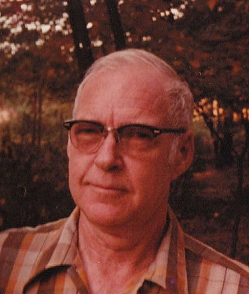|
Switzer, George S.
Birth: Friday, June 11, 1915 in Petaluma, California
Death: Sunday, March 23, 2008 at the age of 92 Laid to Rest: Wednesday, March 26, 2008 in the Saint John Vianney Cemetery Condolences: Click to View or Post |

George S. Switzer – 11 June 1915 – 23 March 2008. Born in Petaluma, CA, son of Albert "Bud" James Switzer & Charlotte Elizabeth Ryan Switzer. Santa Rosa Junior College, 1935; B.A. University of California Berkeley,1937; M.A., Harvard, 1939, Ph.D., Harvard, 1942.
Survived by his wife of 68 years, Sue Joan Bowden Switzer, sons James R. Switzer & J. Mark Switzer, 8 grandchildren & 12 great grandchildren. Preceded in death by his sister Dorothy N. Parr & daughter Patricia Sue Sengstack. Dr. Switzer was an instructor at Stanford University 1939-1940 & at Harvard University 1940-1945; crystallographer Majestic Radio & TV Corp. 1945-1946; director of research Gemological Institute of America 1946-1947; mineralogist US Geological Survey 1947-1948; associate curator Division of Mineralogy & Petrology, National Museum of Natural History, Smithsonian Institution 1948-1964; Chairman Department of Mineral Sciences 1964-1969; Curator Emeritus, Department of Mineral Sciences 1969-1975. He was a Fellow of the Geological Society of America & the Mineralogical Society of America, Secretary of the Geological Society of America 1960-1966, member of the American Gem Society and past Secretary of the Examinations Board for the Gemological Institute of America. Dr. Switzer authored three articles for the National Geographic Magazine, Nov 1951, Apr 1958 & Dec 1968, authored entries for the Encyclopedia Britannica and authored Diamonds in Pictures, 1967 Sterling Pub. Co., co-authored with Cornelius S. Hurlbut, Jr. Gemology 1979 John Wiley & Sons, Inc. Additionally, Dr. Switzer taught undergraduate evening classes at American University for many years. Dr. Switzer was involved in the describing and naming of 5 new mineral species during his career. Working with W. W. Brannock, described and named a new mineral, Veatchite Ca2B6O11 2H2O in 1950. Working with Dr. William F. Foshag, described & named a new mineral Ordonezite ZnSb2O6 in 1955. Described & named a new mineral Paradamite Zn2(AsO4)(OH) in 1956. Working with Howard E. Swanson, described & named a new mineral Paratellurite TeO2 in 1960. Working with Dr. Adolf Pabst and D. L. Sawyer described the phases of Galeite Na2SO4 Na(F,Cl) in 1963. In 1967, Drs. John S. White Jr. & Peter B. Leavens described & named a new mineral Switzerite Mn3(PO4)2 for Dr. Switzer. In 1986, Pier F. Zanazzi redefined Switzerite as Mn3(PO4)2 7H2O and renamed the original form as Metaswitzerite Mn3(PO4)2 4H2O. The naming of any newly discovered species for a professional colleague is perhaps the ultimate compliment one scientist can bestow on another. During 1972 & 1973, Dr. Switzer, his staff & colleagues at the Smithsonian Institution worked on lunar samples from the Apollo 15 & Apollo 16 missions. In 1958, Dr. Switzer's ongoing efforts to develop a major national gem collection were rewarded with the gift of the Hope Diamond by the famed New York jeweler, Harry Winston. The Hope Diamond is the single most popular item in the entire Smithsonian Institution. http://www.pbs.org/treasuresoftheworld/a_nav/hope_nav/main_hopfrm.html On April 27, 1962, Dr. Switzer, unarmed & traveling alone, hand carried the Hope Diamond to Paris for a special exhibition "Ten Centuries of French Jewelry". As with all stories about the Hope Diamond & its Curse, things soon started going wrong. Pan Am flight 116 departed Friendship Airport on time but on its first scheduled stop at Philadelphia a bad landing damaged the plane & caused the reminder of the flight to be cancelled. Forced to maintain secrecy & improvise, Dr. Switzer caught a flight to New York & then Pan Am flight 72 to Frankfurt, Germany. He cabled his French contacts of the situation and worried about the German Customs Officials. Would he be guilty of smuggling? Fortunately, he was able to remain in the transit lounge and wait for his Air Maroc flight to Paris which arrived nine hours behind his original schedule. Greeted by two frantic Louvre museum staff, he was whisked away by car. Just block from his destination the car was involved in a minor auto accident. Retiring from the Smithsonian Institution in 1975 to pursue his decades long hobby of Azalea propagation, he enjoyed 30+ years of active & productive retirement, including the describing & naming of a new Azalea cultivar, Nannie Angell in 1992. In 1999, he received a Certificate of Recognition for his years of service as a Director of the Azalea Society of America and as the Assistant Editor of the Azalean, as well as his Charter Membership & many years service as President of the Ben Morrison Chapter of the Azalea Society of America. He was a Charter Member of the American Chestnut Land Trust and gifts in lieu of flowers can be sent to ACLT P. O. Box 2363 Prince Frederick, MD 20678. Arrangements provided by Rausch Funeral Home. |